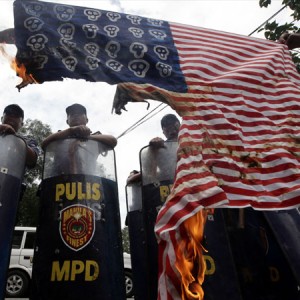
SKULL SPANGLED BANNER Protesters burn a mock American flag during a rally outside the U.S. Embassy in Manila on Wednesday to protest the opening of the formal talks between the U.S. and Philippine governments on the increase of rotational presence of American forces in the country. AP
MANILA, Philippines — A larger U.S. military presence in the Philippines will help the country detect and deter territorial intrusions in the South China Sea through information-sharing but American troops will still be banned from getting involved in regular security operations, the Philippine defense chief said Wednesday.
The last U.S. military base in the Philippines shut down in 1992. The U.S. and Filipino officials began negotiations Wednesday in Manila on a defense agreement that would allow larger numbers of U.S. troops to have temporary access to Philippine military camps and bring in aircraft, ships and other security assets into the country.
Defense Secretary Voltaire Gazmin said a larger U.S. presence can lead to more joint military training and help the Philippines respond to major disasters such as typhoons and earthquakes.
“They’ll feed vital information to us and we’ll take action based on those information,” Gazmin said by telephone, adding both sides would have to agree on the exact number of additional U.S. troops and the military equipment they can temporarily bring to local camps.
“We’d want them near disaster-prone areas so they can help out if problems occur,” he said.
Asked if the Americans would be allowed to stay in Philippine camps near the disputed South China Sea to the country’s west, Gazmin replied that would be considered.
Hundreds of American troops already have been stationed in the southern Philippines for counter-terrorism training since 2002 and also hold annual combat exercises with Filipino troops dealing with Muslim and communist insurgents, along with al-Qaida-linked militants.
But the focus of the Philippine military has increasingly turned to external threats as territorial spats involving China, the Philippines and Vietnam heated up in recent years in the potentially oil- and gas-rich South China Sea.
Foreign Secretary Albert del Rosario said Monday that the Philippines was determined to use diplomacy to resolve the disputes, but stressed the government would do everything to protect its territory.
“Our region needs to know that we are steadfastly for peace,” del Rosario said. “But that we stand ready to tap every resource, to call on every alliance, to do what is necessary, to defend what is ours, to secure our nation and to keep our people safe.”
The presence of foreign troops is a sensitive issue in the Philippines, a former American colony.
The Philippine Senate voted in 1991 to close down major U.S. bases at Subic and Clark, northwest of Manila. In 1999, it ratified a pact with the United States allowing temporary visits by American forces, paving the way for hundreds of U.S. forces to hold combat exercises with Filipino troops in the south.
Left-wing activists held separate protests Wednesday outside the military headquarters, where the negotiations were being held, and in front of the U.S. Embassy, where about two dozen protesters burned a mock American flag and repeatedly yelled, “U.S. troops out.”
The Philippines’ desire to bolster its defense has dovetailed with Washington’s intention to pivot away from years of heavy military engagement in Afghanistan and Iraq to Asia.